The Yucatan Day 1
Travelling in the era of COVID sometimes feels a lot like a game of “the floor is lava.” Entering the US from the EU is prohibited (except to US citizens and EU holders of several specific types of visas), which means that anyone truly desirous of getting there must spend two weeks in a third country – the rule of the game being that after fourteen days in a different country, the restrictions no longer apply.
I was hoping to get back to the US this year, since two of
my friends are getting married (to each other) and I have been itching to pick
up my books from a storage unit in Orange, Connecticut, where I left them two
years ago. At that point I had thought I would be back within fourteen months,
but those plans were completely bulldozed by the pandemic. So anyway, here I
am, not very keen on thinking about how much time has passed, returning to my
alma mater.
Since my family wanted to go on holiday somewhere by the sea
like in the olden days, we decided to spend my mandatory fourteen days outside
of the EU in Mexico. We had already been there once and knew there would be
direct flights to my destination, as well as Baltimore, which is where one of
my sisters was headed afterwards. We also figured this choice of location would
give me and my dad the option to go sightseeing while the rest were lounging by
the beach.
After a few days of some members of my family catching a
nice tan and me getting horribly sunburned (and bitten by a pale green assassin
bug), my dad and I decided to make our two-day trip to the Maya heartland. We
set off from Playa del Carmen a few minutes before six in the morning and
bought an absolutely awful breakfast at a local 7-Eleven. We arrived at Chichén
Itzá at around half past eight.
Having visited Chichén Itzá before (we had been there on our
previous trip to Mexico, along with temples Tulum and Cobá), I paid a little more attention to the
decorations on the walls and platforms, which depict skulls, various animals,
and mythological figures. It is quite easy to miss the details of this
magnificent site because of the grandeur of the main pyramid (Temple of
Kukulcán), but they are well worth noticing. Also remarkable is the sheer number of souvenir
vendors, and I swear, if I ever hear the sound of a jaguar whistle again, I
will lose it.
Chichén
Itzá was built under the influence of multiple Mesoamerican cultures towards
the end of the Classic period of traditional Mesoamerican chronology. The Temple
of Kukulcán, for example, is thought to have been built between the 8th
and 12th centuries CE on a structure constructed slightly earlier.
The main function of the temple was, of course, religious, though the remains
of various sacrifices have largely been found in the nearby cenote
(water-filled sinkhole).
Besides the pyramid, which appears to be purposefully
aligned with the equinoxes, the site boasts a number of other structures
integral to Mayan life. Chichén
Itzá has the largest pre-Columbian ball court in Mesoamerica, a skull
platform (where real skulls were impaled on racks presumably aligned with rows
of skulls in bas-relief), a warrior temple, and a presumed astronomical
observatory. Also impressive is the Group of a Thousand Columns, which must
have supported a massive roof in the city’s heyday.
Perhaps
somewhat surprisingly, we decided it best to go back east after visiting
Chichén Itzá, as our main object in making it our first stop had been to avoid
the afternoon crowds coming from Cancún. We followed the 180D back to Valladolid, turning north on the
295 (if it is not clear by now, I did the navigating) and arriving at the
temple Ek’ Balam shortly after eleven o’clock. Having been despoiled of an unchristian
533 pesos a person at Chichén Itzá,
we were unable to procure the similarly unchristian sum (475 pesos a person, I
believe) at Ek’ Balam, so we paid in American dollars. There is no doubt in my
mind that this money, so graciously accepted, went straight into the pocket of
the rather phlegmatic ticket officer.
Ek’ Balam was quite a sight to behold, and its towering,
pristine presence in the middle of the jungle was reinforced by a comparative
dearth of tourists. Unlike in Chichén Itzá, many of the structures at Ek’ Balam
(basically anything with stairs) can be climbed, with the main pyramid offering
sweeping views of two smaller structures emerging from endless forests. As is
true of many other Mayan sites, the main pyramid in Ek’ Balam was built in
almost perfect alignment with the four cardinal directions, though some of the
other structures are a little less harmonious. Like Chichén Itzá, it was a
prosperous city state towards the end of Classic Period (which is usually
defined as 250–900 CE) but was abandoned not long after for unknown reasons.
Being the bunch of lunatics we are, though with method to
our madness, we hopped straight back onto the 295 and westwards onto the 180D again
to our next destination. Speaking of highways in such intimate terms, I just
remembered a funny tidbit from our morning anabasis. As we ascended the 305D, I
was quite surprised to find the whole process to be automated. We pressed a
button, received a card, and were told to continue. However, when we tried to proceed, the toll-bar would not
budge. It was only then that a young woman emerged from the darkness to lift
the toll-bar and let us through – an ironic servant to the gods of
automatisation.
Riding the
180D is quite an experience. Stretching all the way from Cancún to Kantunil,
where it joins the 180 again, it is essentially a high-speed, low-occupancy
tunnel through one foresty half of the Yucatan. Unfortunately, much of it is
being repaired right now, which means cars are often funnelled into single
files that are meant to travel at 20 kmph. The indomitable Mexican spirit,
however, makes little of such stringent rules and we found that even driving
four times the speed limit is still a major inconvenience to other drivers.
Unsurprisingly, several segments of the highway are littered with battered
traffic cones.
Taking a
right at Kantunil, we drove through several small towns before arriving at
Izamal, our next destination. On our way there, we passed by the tiny,
picturesque town of Xanabá, dominated by a very Spanish-looking, lemon-yellow
church festively decorated with buntings of colourful triangular flags. It was
there that the pandemic once again reared its ugly head, leading a queue that
snaked its way around the entire main square. We learned from a local traffic
cop that these unfortunate people carrying umbrellas and bottles of water to
protect themselves from the scorching heat were waiting to get their COVID-19 shots,
which had just arrived in town as part of a national vaccination drive.
Izamal was
a rather pretty town, compactly centred around the Convent of Saint Anthony of
Padua. Unlike at many other places we visited during our trip, we didn’t have
to pay any entry fees, and the policeman we asked about the matter amusedly
remarked that “one does not pay to enter the house of God.” Nevertheless, our
finances had already hit rock bottom by then, so my dad went to withdraw money
from a bank while I clambered up a local pyramid called Kinich Kakmó.
It is quite
remarkable that Kinich Kakmó, as well as several other major pre-Columbian
structures, has survived until the present day despite being so close to the
city centre. Nevertheless, it is not as well-preserved as the Temple of Kukulcán and many buildings sacred to the
Maya in Izamal and other cities were taken apart to serve as foundations for Catholic
churches. Indeed, much of the city, all painted in the same yellow as the
convent, appears to be nothing more than a vast extension thereof.
We were
making good time as we left Izamal, so we decided to squeeze in a short visit that
we were going to make the following day. Driving farther west, we arrived at Aké around half past three. This not
very famous Maya site must have been a major hub in the Early Classic era, when
a raised paved road connected it to Izamal and its numerous pillars supported
the roof of what must have been a very important municipal building. The entire
site, however, was closed, with a little sign apologising for this
pandemic-related inconvenience.
Consequently, the most interesting thing we saw in Aké was
not its temple, but a Sisal factory just across the parking lot. Having clearly
outlived its formed glory, it comprised two buildings, one giant and entirely
dilapidated, and the other somewhat shoddy but still in use. A small rail
continues to link these two structures together, possibly serving to transport
materials from place to place.
Our last stop of the day was Mérida, where we visited the picturesque city centre and walked down
a portion of the famed Paseo Montejo. Unbeknownst to me before this trip, the
Cathedral of Mérida is the
oldest cathedral on the mainland of the Americas, and the second oldest in the
New World. Despite this solemn (and not very ornate) presence, the rest of the
historic city centre is full of vivacious colours and opulent rococo detail. The
grandiose mansions on Paseo de Montejo are similarly not to be missed.
We were quite fortunate in our timing, as a huge storm broke
out just as we were heading back to our rental car. Driving out of the city
centre, however, became a bit of a thriller, as decreased visibility turned
(already widely disregarded) traffic laws into the law of the jungle. We
arrived at our hotel near Uxmal just in time for dinner.





















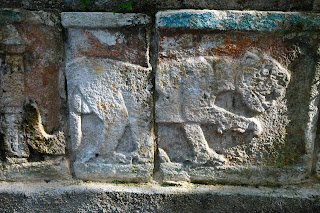
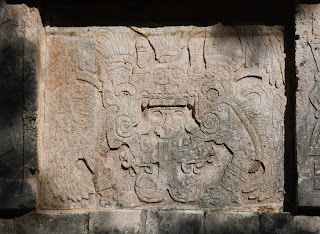




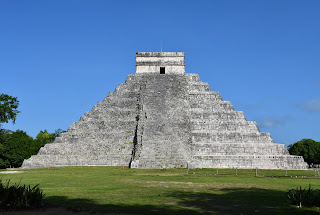



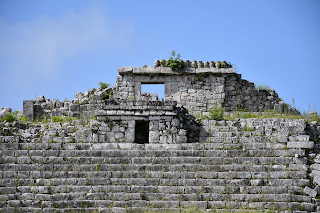




























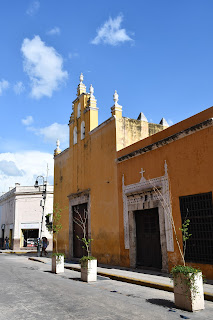
























Comments
Post a Comment